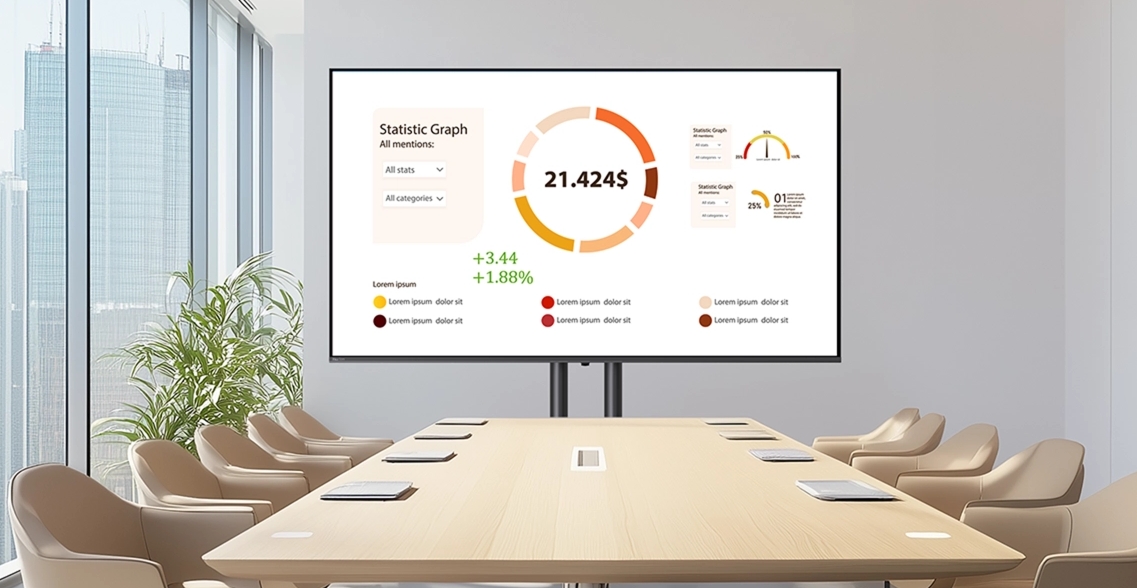Interactive Screens for Business: How to Choose the Right Solution for Boardrooms & Meeting Spaces?
Why Do Corporate Meeting Spaces Need Interactive Screens?
Interactive screens for business have revolutionized the way teams collaborate in modern workplaces. Unlike traditional displays, these smart solutions enhance engagement by allowing real-time annotations and seamless content sharing. They eliminate the inefficiencies of outdated projectors and static presentations. Companies adopting interactive screens report faster decision-making and smoother idea exchanges. With remote and hybrid work on the rise, these tools support flexible collaborations across locations. Interactive screens also reduce dependency on physical whiteboards, keeping discussions digital and easily retrievable. Their intuitive interfaces minimize the learning curve, ensuring employees adopt them effortlessly. For businesses aiming to stay competitive, interactive screens are no longer a luxury—they’re a necessity. Investing in the right solution improves both productivity and meeting culture. Ultimately, interactive screens for business bridge the gap between technology and teamwork.

Capacitive vs. Infrared: Which Technology Fits Meeting Rooms Best?
When selecting interactive screens for business, understanding touch technology is crucial. Capacitive screens offer highly responsive, multi-finger touch—ideal for detailed annotations and precision work. Infrared screens, on the other hand, support stylus and gloved touch, making them versatile for diverse users. Capacitive displays often provide better image clarity, which is beneficial for high-resolution presentations. Infrared panels excel in durability, resisting scratches and fingerprints common in high-traffic meeting rooms. Some businesses prefer capacitive screens for their sleek, modern designs and smooth tactile experience. However, infrared solutions tend to be more cost-effective for large-scale deployments. The choice depends on how users interact with the screen daily. For collaborative environments, multi-touch infrared models might be the better fit. Before deciding, test both technologies to see what aligns with your team’s workflow. Interactive screens for business must balance functionality with practicality.
Essential Features for Meeting Collaboration: Multi-Device Casting & Whiteboard Writing
The best interactive screens for business prioritize features that enhance teamwork. Multi-device wireless casting allows presenters to switch between laptops and phones effortlessly. Built-in digital whiteboards encourage spontaneous brainstorming without switching apps or tools. Annotation capabilities should work in real-time during video calls for remote participants to contribute. Look for screens that support multiple simultaneous users to foster true collaboration. Some models integrate with cloud storage, making saved notes accessible across devices instantly. A user-friendly interface ensures employees of all tech levels can participate without frustration. Touch responsiveness must be instant to maintain meeting momentum and engagement. The ability to split the screen for side-by-side comparisons improves efficiency. These features make interactive screens for business invaluable assets in any meeting space.
Anti-Glare & Low Blue Light: The Overlooked Health & Comfort Factors
Long meetings strain employees’ eyes, but the right interactive screens for business can help. Anti-glare coatings reduce reflections from overhead lighting and windows, improving visibility. Low blue light technology minimizes eye fatigue during extended screen use—a must for back-to-back meetings. Some models adjust brightness automatically based on ambient lighting conditions. These health-focused features contribute to productivity by keeping teams comfortable. Employees in bright or open-plan offices particularly benefit from glare reduction. Healthier screens also improve concentration and reduce meeting fatigue over time. When evaluating options, prioritize displays certified for prolonged workplace use. Interactive screens for business should enhance, not hinder, employee well-being. A comfortable viewing experience leads to more effective discussions.
From Installation to Maintenance: A Business Buyer’s Checklist
Choosing interactive screens for business extends beyond features—durability and support matter. Consider installation requirements: some panels need professional mounting, while others are plug-and-play. Wall-mounted or mobile stands should align with your meeting room’s flexibility needs. Verify warranty coverage and average lifespan to anticipate long-term costs. Opt for brands offering reliable after-sales service and software updates. Dust-resistant and rugged designs endure daily use in busy corporate environments. Check compatibility with existing collaboration platforms like Microsoft Teams or Zoom. On-site or remote troubleshooting services prevent prolonged downtime. Factor in future scalability—can you easily add more screens as needed? Interactive screens for business are long-term investments, so prioritize hassle-free ownership.
By focusing on these key aspects, businesses can select interactive screens that truly enhance meeting efficiency and collaboration. Investing in the right technology today prepares your workspace for tomorrow’s demands.
